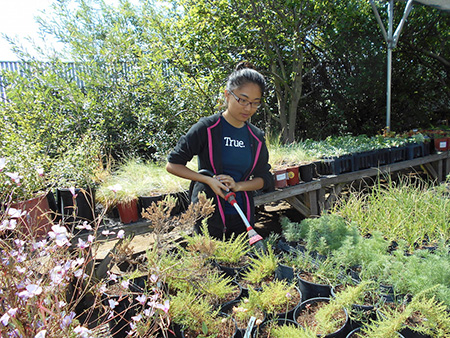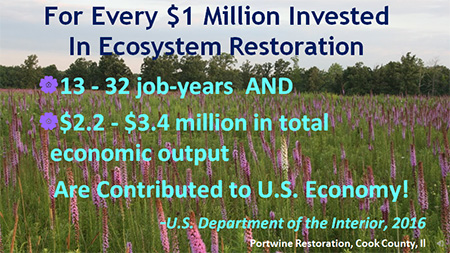Native Plant Conservation Campaign News: U.S. moving to meet expanding demand for locally adapted native plants and seed for restoration
June 15, 2021
Agencies and scientists around the world have identified
shortages of locally adapted native plants and seed as fundamental barriers to restoration of

lands devastated by wildfires, hurricanes and mismanagement. As the
National Academies of Sciences has stated, native seeds are also in demand for applications in urban land management, roadside maintenance, conservation agriculture, and other restorative activities that take into account the connection between native plant communities and the increasingly urgent need for resilient landscapes to combat climate change.
In the United States, federal and state governments are stepping up to meet the growing demand.
In New Jersey, a bill establishing the "Jersey Native Plants Program" passed the state Senate in March.
Senate Bill 83, sponsored by republican Senator Kip Bateman, would create a program in the Department of Agriculture to promote the sale of New Jersey native plants in garden centers and nurseries. Similar to the “Jersey Fresh” and “Jersey Grown” initiatives, which encourage purchase of locally grown produce, this program would create a labeling system to identify plants which are “Jersey natives.” New Jersey has approximately 2,100 native plant species; 19 globally rare plants have their largest or most viable populations in the State.
In California, Native Plant Society of the United States*
Affiliate the
California Native Plant Society has launched the
Bloom! California program with funding from the U.S. Department of Agriculture. The first program of its kind in the state, the campaign seeks to boost the sale of California native specialty plants by 20% over the next three years. The program is recruiting local nurseries to help increase production of natives. In return, the program will publicize participating nurseries as it works to raise awareness about the
benefits of local native plants.
The Bloom! program will provide assistance to projects like San Francisco’s
Literacy for Environmental Justice, which “promotes ecological health, environmental stewardship, and community development in underserved communities by creating urban greening, eco-literacy, community stewardship and workforce development opportunities”, primarily for youth. Their
Native Plant Nursery propagates “hyper local” native plants from remnant San Francisco ecosystems for habitat restoration in public open spaces throughout the city.
New York City has a similar nursery program at its
Greenbelt Native Plant Center, which is part of the Department of Parks and Recreation. Their 13

acre nursery grows and distributes plants native to the City for restoration of parks and other spaces. They also bank local native seed for future projects. Currently 600 species are banked at their facility.
Finally, the National Academies of Sciences has formed a
Committee to perform a comprehensive national
Assessment of Native Seed Needs and Capacities. This Assessment will identify causes of the shortages of locally adapted native seed for restoration on federal lands and elsewhere. It will also suggest solutions to these problems so that the U.S. can better restore and conserve healthy, resilient and productive landscapes. The committee recently released an
Interim Report detailing their progress.
Economic Benefits Too!
All of these efforts will yield not only ecological benefits, but social and economic gains as well. According to a 2016
US Department of the Interior analysis, every $1million spent on ecosystem restoration substantially boosts both employment and economic output** in the project area.
*The Native Plant Conservation Campaign is changing our name to the Native Plant Society of the United States.*
This name better reflects the nature of the organization.
Our mission remains the same.
**Job-years measure the total number of annualized full and part-time jobs accumulated over the duration of a restoration project. Economic output measures the total value of the production of goods and services supported by project expenditures.
Learn more about the National Academy of Sciences Native Seed Assessment at
their website
Images: Native Plant Nursery © Literacy for Environmental Justice San Francisco; Economic Benefits © Native Plant Society of the United States
 lands devastated by wildfires, hurricanes and mismanagement. As the National Academies of Sciences has stated, native seeds are also in demand for applications in urban land management, roadside maintenance, conservation agriculture, and other restorative activities that take into account the connection between native plant communities and the increasingly urgent need for resilient landscapes to combat climate change.
lands devastated by wildfires, hurricanes and mismanagement. As the National Academies of Sciences has stated, native seeds are also in demand for applications in urban land management, roadside maintenance, conservation agriculture, and other restorative activities that take into account the connection between native plant communities and the increasingly urgent need for resilient landscapes to combat climate change.  acre nursery grows and distributes plants native to the City for restoration of parks and other spaces. They also bank local native seed for future projects. Currently 600 species are banked at their facility.
acre nursery grows and distributes plants native to the City for restoration of parks and other spaces. They also bank local native seed for future projects. Currently 600 species are banked at their facility.